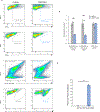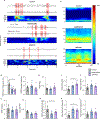Reduction in GABAB on glia induce Alzheimer's disease related changes
- PMID: 36906075
- PMCID: PMC10115139
- DOI: 10.1016/j.bbi.2023.03.002
Reduction in GABAB on glia induce Alzheimer's disease related changes
Abstract
Alzheimer's Disease (AD) is a neurodegenerative disorder characterized by beta-amyloid plaques (Aβ), neurofibrillary tangles (NFT), and neuroinflammation. Data have demonstrated that neuroinflammation contributes to Aβ and NFT onset and progression, indicating inflammation and glial signaling is vital to understanding AD. A previous investigation demonstrated a significant decrease of the GABAB receptor (GABABR) in APP/PS1 mice (Salazar et al., 2021). To determine if changes in GABABR restricted to glia serve a role in AD, we developed a mouse model with a reduction of GABABR restricted to macrophages, GAB/CX3ert. This model exhibits changes in gene expression and electrophysiological alterations similar to amyloid mouse models of AD. Crossing the GAB/CX3ert mouse with APP/PS1 resulted in significant increases in Aβ pathology. Our data demonstrates that decreased GABABR on macrophages leads to several changes observed in AD mouse models, as well as exacerbation of AD pathology when crossed with existing models. These data suggest a novel mechanism in AD pathogenesis.
Keywords: Alzheimer’s Disease; Amyloid; Electrophysiology; Flow cytometry; GABABR; Glia; Mouse models; NanoString.
Published by Elsevier Inc.
Conflict of interest statement
Declaration of Competing Interest The authors declare that they have no known competing financial interests or personal relationships that could have appeared to influence the work reported in this paper.
Figures






References
-
- al-Dahan MI, & Thalmann RH (1996). Progesterone regulates gamma-aminobutyric acid B (GABAB) receptors in the neocortex of female rats. Brain Research, 727(1–2), 40–48. - PubMed
-
- Alam Q, Alam MZ, Mushtaq G, Damanhouri GA, Rasool M, Kamal MA, & Haque A (2016). Inflammatory Process in Alzheimer’s and Parkinson’s Diseases: Central Role of Cytokines. Current Pharmaceutical Design, 22(5), 541–548. - PubMed
Publication types
MeSH terms
Substances
Grants and funding
- P50 AG016574/AG/NIA NIH HHS/United States
- R01 AG017917/AG/NIA NIH HHS/United States
- P30 AG010161/AG/NIA NIH HHS/United States
- R01 AG032990/AG/NIA NIH HHS/United States
- R01 NS080820/NS/NINDS NIH HHS/United States
- P20 GM109025/GM/NIGMS NIH HHS/United States
- U01 AG046139/AG/NIA NIH HHS/United States
- P01 AG017216/AG/NIA NIH HHS/United States
- R01 AG018023/AG/NIA NIH HHS/United States
- U54 AG054345/AG/NIA NIH HHS/United States
- R01 AG023571/AG/NIA NIH HHS/United States
- P01 AG003949/AG/NIA NIH HHS/United States
- U24 NS072026/NS/NINDS NIH HHS/United States
- P30 AG019610/AG/NIA NIH HHS/United States
- P50 AG025711/AG/NIA NIH HHS/United States
- U01 AG006786/AG/NIA NIH HHS/United States
- R01 AG036836/AG/NIA NIH HHS/United States
- R01 AG015819/AG/NIA NIH HHS/United States
LinkOut - more resources
Full Text Sources
Medical
Molecular Biology Databases

